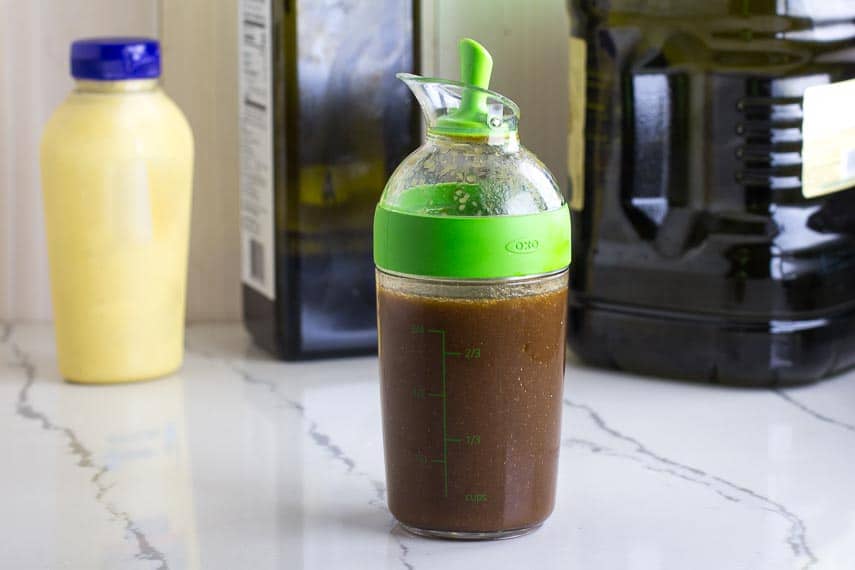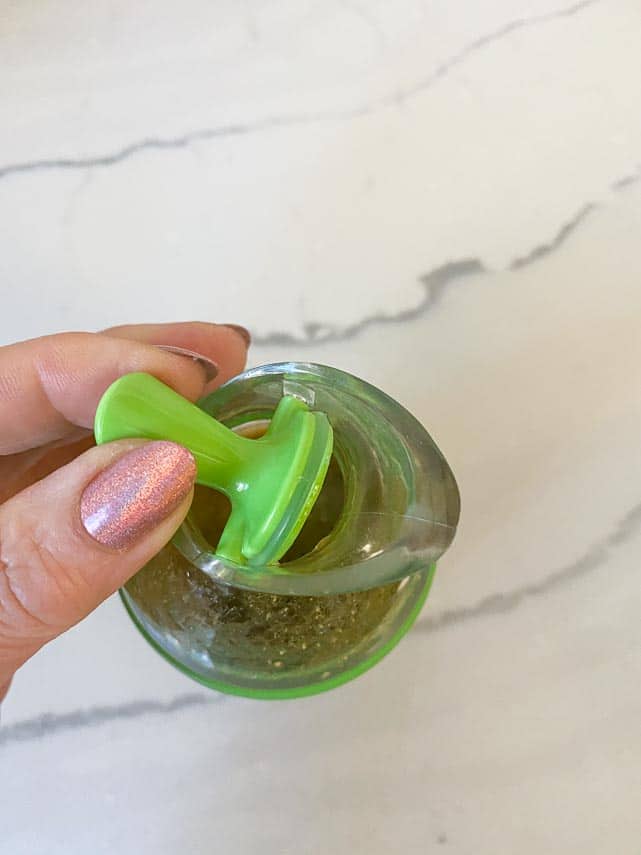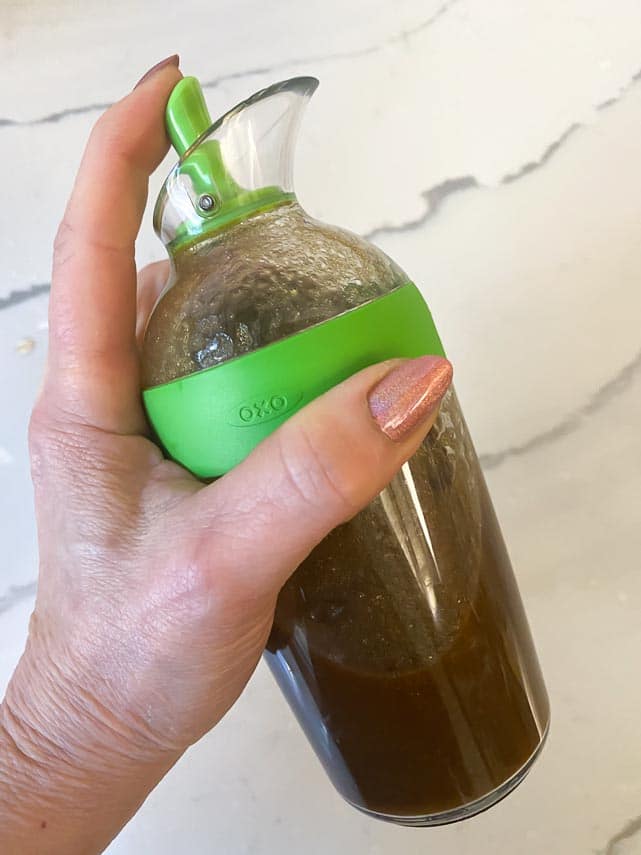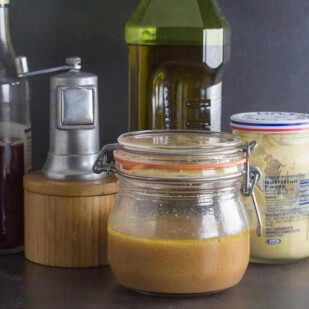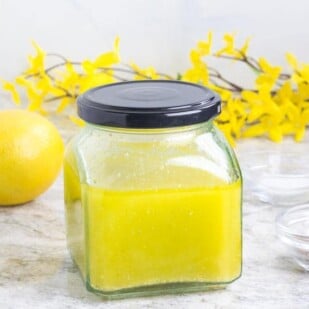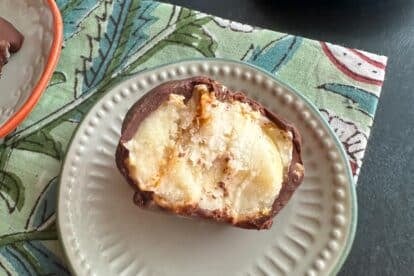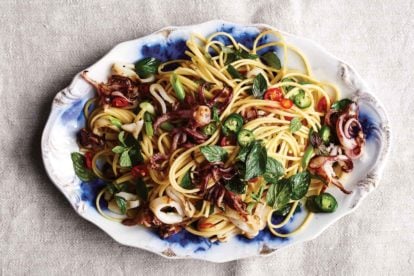Got 2 minutes? Make homemade salad dressing! We love making salad dressings from scratch and our Low FODMAP Balsamic Vinaigrette is the one we turn to most often. The sweet yet tangy flavor profile of balsamic vinegar accents our daily green salad perfectly. All you need is balsamic vinegar, good olive oil and a bit of Dijon mustard.
Balsamic Vinegar Is Low FODMAP
Are you surprised to see balsamic vinegar in a low FODMAP recipe? Perhaps that is because it has a big fat Yellow Light next to it on the Monash app indicating “Moderate” FODMAPs?
As always, you must click through to read the entire app entry. You will see that 1 tablespoon or 21 g is Green Light Low FODMAP. And that tablespoon is an Australian tablespoon, which means that it is really about 1 tablespoon plus 1 teaspoon in volume that is low FODMAP. As part of a vinaigrette that is plenty!
About Balsamic Vinegar
Traditional balsamic vinegar is made in Reggio Emilia and Modena, Italy and the production is overseen by a special certifying agency. “Aceto Balsamico Tradizionale” carries a D.O.P. (“Denominazione di Origine Protetta”) stamp. This is a European Union certification that guarantees quality, production and place of origin. The only ingredient is grape must.
Grape must is made by pressing whole grapes complete with stems, skin, seeds and juice. The resulting must is cooked down until concentrated, then naturally fermented for a few weeks. Then it is matured for a minimum of 12 years in a series of barrels, each made from a different type of wood: oak, chestnut, cherry, juniper and mulberry wood are used. Every step of the process is important in producing the complex flavors, texture and color of the final vinegar.
This kind of vinegar is used sparingly, as a condiment, and can cost $200 an ounce or more. This is not the kind of balsamic vinegar you will be using for your vinaigrette.
Here are our recommendations for some balsamic vinegars that are much more affordable and work quite well in our Low FODMAP Balsamic Vinaigrette:
- Roland Diamond Balsamic Vinegar (economical)
- Oliviers & Co. Balsamic Vinegar of Modena
- Acetaia Malpighi Balsamo of Modena
- Star Balsamic Vinegar of Modena (mid-level budget choice)
- Monari Federzoni Balsamic Vinegar of Modena (economical)
Dijon Mustard Is Low FODMAP, Too!
We love mustard as a condiment. Spread on bread for sandwiches, added to sauces (like cheese sauce, or Maple Mustard Sauce!) or in salad dressings like this. Monash University has lab tested several types of mustard, including Dijon.
Dijon mustard is low FODMAP in 1 Australian tablespoon portions. We always have a jar in the Test Kitchen fridge!
(If you are a condiment fan like us, check out our Ultimate Guide to Low FODMAP Condiments article).
What Is “Good” Olive Oil?
First of all, let’s talk about the fact that any pure oil is low FODMAP as it is a fat and contains no carbohydrates. When it comes to olive oil, we have always used it in our cooking, pre-FODMAP and now as well.
A “good” olive oil is one that you enjoy. Some are buttery and smooth. Some are sharp, peppery and/or astringent. They all have their place and we often have more than one bottle going at any given time. Use what you like for this vinaigrette.
Here are some olive oils that we love:
- California Olive Ranch Everyday Extra Virgin Olive Oil
- Napa Valley Naturals Organic Extra Virgin Olive Oil
- O-Live & Co. Everyday Extra Virgin Olive Oil
- Gaea Greek Extra Virgin Olive Oil
- Frantoia Barbera Sicilian Extra Virgin Olive Oil
- Filippo Berio Extra Virgin Olive Oil (a good budget choice)
- Kirkland Signature Extra Virgin Olive Oil (another great budget choice)
We usually stick with cold-pressed extra-virgin olive oils for our salad dressings.
Ratios
A classic vinaigrette is all about ratios. The classic is 3 parts oil to 1 part vinegar. Usually that is too oil-rich for me and I go heavier on the vinegar, but when it comes to balsamic, we need to heed low FODMAP portions.
Malt vinegar, for the record, contains no FODMAPs, so you can be as liberal as you like.
Red wine vinegar, another salad dressing favorite, has a generous low FODMAP serving size of 2 Australian tablespoons, as does rice wine vinegar and apple cider vinegar.
So, you can see that you have choices. If you love balsamic vinegar, then simply test it on yourself when you are stable and in your Challenge Phase and see if you can tolerate more.
Serving Size Of Salad Dressing
We have set our serving size of salad dressing at 2 tablespoons, however, if you are trying to max out your serving, you could have more.
⅓ cup (75 ml) of balsamic vinegar equals 5 ⅓ tablespoons. That equals 16 teaspoons. The low FODMAP serving size of balsamic vinegar is 4 teaspoons. This means that you could divide this recipe into 4 servings, which would be quite a bit.
How To Make Low FODMAP Balsamic Vinaigrette
LOL, no I didn’t do step-by-step images for this recipe! Just shake the ingredients together in a jar! That’s it.
You can see that the top has a clear gasket, which helps it stay airtight.
And it really is! The design is such that you naturally grasp it and place one finger on top and you can shake, shake, shake with no drips.
More Low FODMAP Salad Dressings
- Red Wine Vinaigrette
- Sherry Vinaigrette (see notes in recipe for more FODMAP info)
- Poppy Seed Salad Dressing
- Blue Cheese Dressing
- Green Goddess Dressing
- Avocado Vegan Green Goddess Dressing
- Russian Dressing
- Lemon Salad Dressing
- Ranch Dressing
- Homemade Caesar Salad Dressing
- Malt Vinegar Salad Dressing
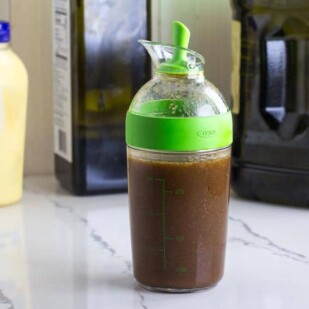
Low FODMAP Balsamic Vinaigrette
We love making salad dressings from scratch and our Low FODMAP Balsamic Vinaigrette is the one we turn to most often. The sweet yet tangy flavor profile of balsamic vinegar accents our daily green salad perfectly. All you need is balsamic vinegar, good olive oil and a bit of Dijon mustard.
Low FODMAP Serving Size Info: Makes 1 ¼ cups; 10 servings; serving size 2 tablespoons
Ingredients:
- 1 cup (240 ml) extra-virgin olive oil
- 1/3 cup (75 ml) balsamic vinegar
- 1 tablespoon Dijon mustard; see Tips
Preparation:
-
Place oil, vinegar and mustard in a lidded jar, screw down the lid tightly and shake, shake, shake.
-
Your Low FODMAP Balsamic Vinaigrette is ready to use or may be stored at room temperature for up to 4 days.
Notes:
Tips
Variations:
• Feel free to use either our Garlic-Infused Oil or Onion-Infused Oil, made with olive oil, of course.
• You can add more or less mustard. Low FODMAP serving size is up to 1 Australian tablespoon per serving, so you have leeway.
• You can add chopped scallion greens or chives if you like.
• Fresh herbs are a nice addition, too. Use your Monash app to look up amounts.
• Some folks like a little honey. Try 1 teaspoon per recipe (it will remain low FODMAP).
• I do not think our recipe needs salt or pepper but feel free to add a little kosher salt and/or freshly ground black pepper if you like.
Storage: If you make the vinaigrette as described in the main recipe, it will keep for several days at room temperature. If you add any fresh ingredients, such as scallions, chives or herbs, then the vinaigrette should be used immediately or refrigerated for 3 days. Bring to room temperature and shake well before using.
FODMAP Information
Our recipes are based on Monash University and FODMAP Friendly science.
- Garlic-Infused Oil: Make your own Garlic-Infused Oil or buy a commercial equivalent for the easiest way to add garlic flavor to your food. Fructans in garlic are not oil-soluble, so garlic-infused oil is low FODMAP.
- Oil: All pure oils are fats and contain no carbohydrates, therefore they contain no FODMAPs.
- Onion-Infused Oil: Make your own Onion-Infused Oil or buy a commercial equivalent for the easiest way to add onion flavor to your food. Fructans in onions are not oil-soluble, so onion-infused oil is low FODMAP.
Please always refer to the Monash University & FODMAP Friendly smartphone apps for the most up-to-date lab tested information. As always, your tolerance is what counts; please eat accordingly. The ultimate goal of the low FODMAP diet is to eat as broadly as possible, without triggering symptoms, for the healthiest microbiome.
Nutrition
All nutritional information is based on third-party calculations and should be considered estimates. Actual nutritional content will vary with brands used, measuring methods, portion sizes and more. For a more detailed explanation, please read our article Understanding The Nutrition Panel Within Our Recipes.
